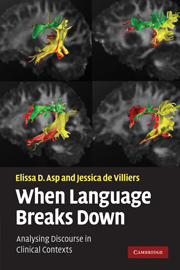Book contents
- Frontmatter
- Contents
- List of figures
- List of tables
- Acknowledgements
- Transcription conventions
- Introduction
- 1 Introduction to clinical discourse analysis
- 2 Theoretical and clinical contexts
- 3 Talk and speech – conversation analysis and intonation in English
- 4 Grammar
- 5 Phase and contexts of culture and situation
- 6 Study design
- 7 Differential diagnosis and monitoring
- 8 Cognitive models, inferencing and affect
- 9 Modelling information across domains
- Closing remarks
- Notes
- Appendix A Some basic grammatical terminology and relations
- Appendix B Inventory of codes
- References
- Author index
- Subject index
3 - Talk and speech – conversation analysis and intonation in English
Published online by Cambridge University Press: 05 June 2012
- Frontmatter
- Contents
- List of figures
- List of tables
- Acknowledgements
- Transcription conventions
- Introduction
- 1 Introduction to clinical discourse analysis
- 2 Theoretical and clinical contexts
- 3 Talk and speech – conversation analysis and intonation in English
- 4 Grammar
- 5 Phase and contexts of culture and situation
- 6 Study design
- 7 Differential diagnosis and monitoring
- 8 Cognitive models, inferencing and affect
- 9 Modelling information across domains
- Closing remarks
- Notes
- Appendix A Some basic grammatical terminology and relations
- Appendix B Inventory of codes
- References
- Author index
- Subject index
Summary
Introduction
In this and the following two chapters we present descriptive resources which allow coding of spoken discourse in terms of conversational, grammatical, pragmatic and contextual features. Features that are coded can be counted. This allows both ‘pattern finding’, a replicable way of proceeding inductively to characterizations of discourse (a specialized kind of data mining), and ‘hypothesis checking’ where analyses in terms of the presence, absence, frequency and/or co-occurrence of discourse features are hypothesized to be associated with particular disorders, neurocognitive states, or changes in neurocognitive states.
Our goal is pragmatic: we do not enter into debates or account for the historical development of particular concepts or constructs, but present criteria for description that allow understanding and reliable coding of discourse features. Often this means that we are presenting ‘hybrid’ models, synthesized from works in functional, ethnographic, interactional and formal linguistic traditions. We refer readers to these works but discuss them only when such discussion seems essential for understanding.
The order of presentation, from conversational to contextual analysis, is intended to proceed from the familiar to, perhaps, less familiar ways of describing discourse. However, as is inevitably the case, some terms appear that presuppose knowledge of others presented later. For the most part, we address this by providing examples and/or glosses of terms and references. We use normative examples rather than examples from clinical contexts in presenting the grammar. Normative examples are practical insofar as they do serve to illustrate without the addition of marked features or other distractions.
- Type
- Chapter
- Information
- When Language Breaks DownAnalysing Discourse in Clinical Contexts, pp. 29 - 43Publisher: Cambridge University PressPrint publication year: 2010



